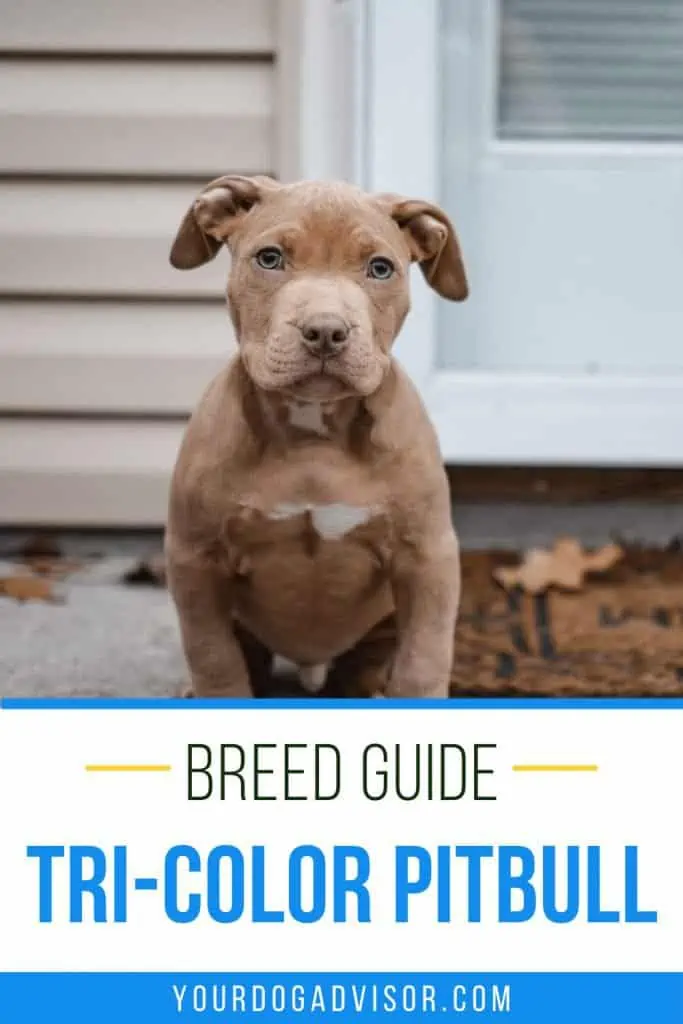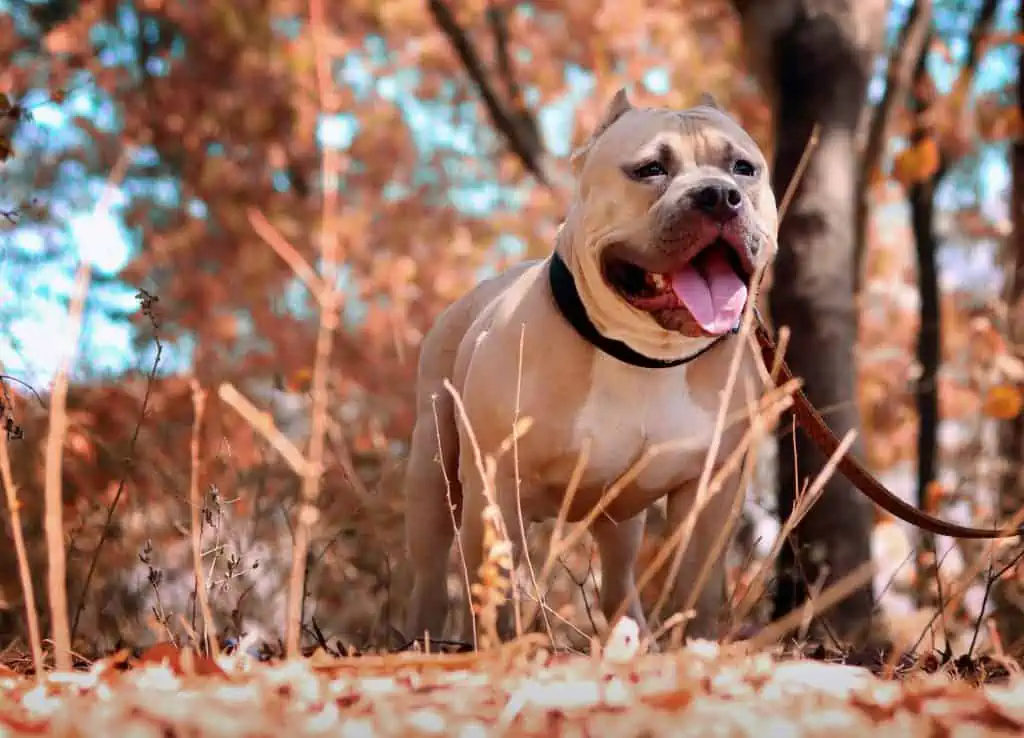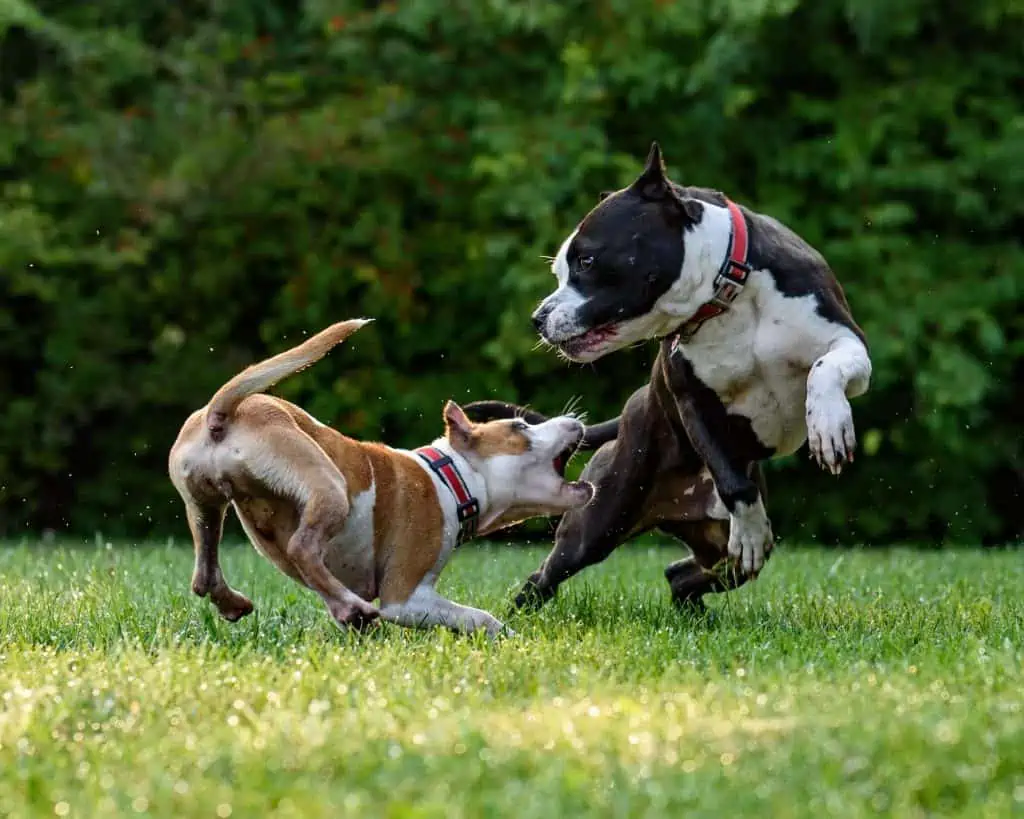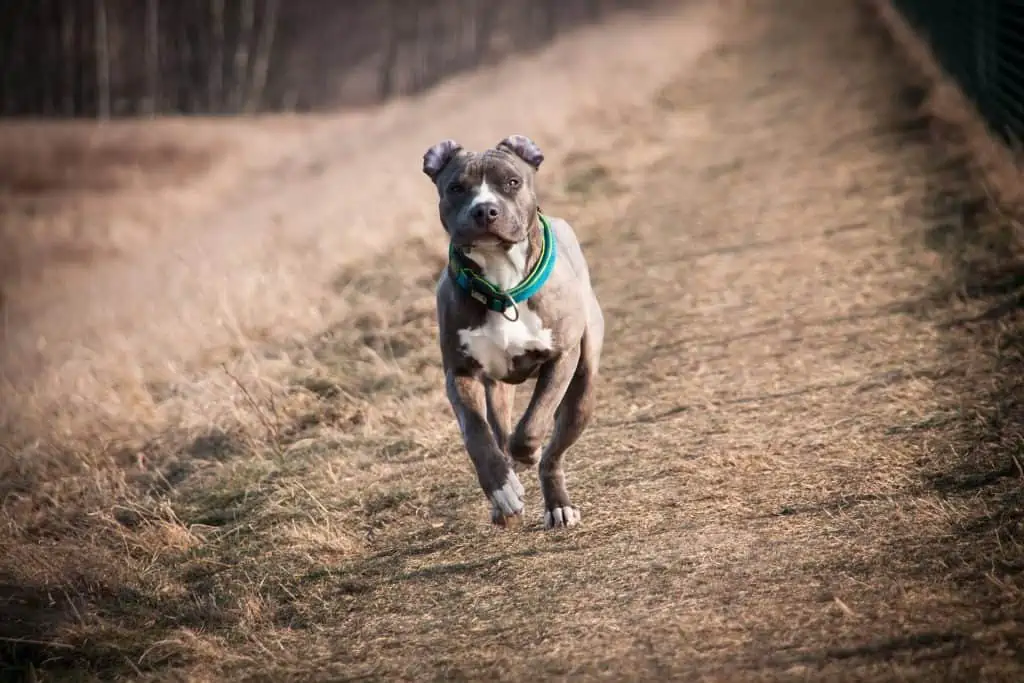A rare and excitingly beautiful breed, a tri color pitbull is gaining fame unremarkably fast. With varying color patterns, it is no doubt that they are gaining so popularity among dog owners.
Almost all major Pitbull breeds like American Pitbull Terriers, American Staffordshire Terriers, and Staffordshire Bull Terriers reproduce puppies in more than two hues called the tri color Pitbulls. Breeders and dog owners alike have gotten so immersed in this new tri color scheme that they seek different cross-overs for new color variations.
The color scheme is diverse, and as tri color Pitbulls are relatively rare, we will share a few popular combinations among dog owners and breeders.
At the end of the day, it is still a Pitbull, and there are many ongoing myths. The main ones are mostly linked to their aggressiveness. However, like every dog breed, with the proper training, they turn out to be gentle, caring, and loving family dogs.
As a new owner or a parent wanting to learn more about the variations, or health conditions linked to them, we have created a comprehensive guide to help you out. Keep reading to learn more about them.
Pitbulls are caring animals and great companions. With the right training, they turn out as great family dogs.
Contents
What Is a Tri Color Pitbull?
The word tri color refers to the three different remarkable hues on the shedding coat instead of two. The color pattern mainly ranges between basic black or lilac to white or tan. Almost all color variations follow this pattern.
The genetic variations linked are complex, and several dangerous health conditions can arise. The gene responsible for this color scheme is the tan point allele in the agouti gene series. For a puppy to be a tri color Pitbull, both recessive alleles should be inherited from both parents.
Even with three different sets of colors, the possibilities are endless. The main reason why breeders and owners fancy such a unique variation. And, as they keep growing famous, so will the experiments to breed new fancy combinations.
History
A Pitbull (also known as Americal Pitbull or Staffordshire Terrier) is an umbrella of several related breeds. Their origin dates back to the early 19th Century when they were bred from Old English Bulldogs for hunting and a cruel sport called “bull baiting”. However, the game was soon made illegal by the UK government. But they were imported to the US since the games were still legal here.
Other than that, their breeding continued for many different roles like farming, protecting the family, looking over the children, protecting the livestock from predators, and being hunting companions.
Due to their exemplary roles in different fields, their popularity grew among the breeders. The newspapers and media took attention, and they were recognized as a breed by the United Kennel Club in 1898 as the American Pitbull Terrier. The American Kennel Club (AKC) succumbed to the ongoing popularity and recognized it as a breed in 1935.
The misconceptions revolving around the breed regarding their aggressiveness are not entirely true. Many big organizations like the ADBA condemn this behavior toward Pitbulls. Any dog breed, if not properly trained can show aggressive traits. Pitbulls trained for hunting and protection will likely show aggressiveness, while the dogs trained in a loving, caring environment will turn out docile.
Temperament & Personality of Tri Color Pitbulls
The temperament and personality of tri color Pitbulls are closely related to the Pitbull breed they belong to. However, these multi-colored dogs are better companions than their counterparts. But, this doesn’t mean that Pitbulls are aggressive by nature. They are friendly, jolly, and playful like any other dog breed.
The role of media in portraying the aggressiveness of Pitbulls is a growing concern. It has been proven through numerous studies that any breed is prone to aggressive behavior if not properly trained. The Pitbulls were known for their friendly companionship, but their misuse as a hunting dogs has created unnecessary fear among dog owners.
Research conducted by the American Temperament Test Society ranked Pitbull Terriers second regarding tolerance.
Pitbulls are friendly, welcoming, and family dogs. Known as the “clown dogs” among the canines, they do unnecessary stuff to make humans laugh. They are great companions and shower love to their owners. With proper socialization, they can become everyone’s favorites.
The most welcoming characteristic you will see is their friendliness with children. They act as their nannies and are cheerful around them. Being quite popular among children, they are excellent babysitters and can put up with them.
The behavior problems arise when the social training does not go well. The anxious behavior often shows the lack of proper training during its pup life. It is possible to resolve the problem with regulated social interactions and behavior classes. That will equip your puppy with the necessary skills, and he will react less to unforeseen events.
Pitbulls are not aggressive. With proper and mindful socialization, they turn out as docile as any other dog breed.
Medical Care & Health
tri color Pitbulls enjoy a long lifespan of 8 to 16 years. As purebred, they are comparatively healthy and have fewer genetic health conditions.
Like every breed, there are a few conditions that can affect the lifestyle and lifespan of your pup if not treated and cared for well. Following are a few common health conditions associated with Pitbulls.
- Bloat
Bloat is very common in large dogs with a deep chest. It is a life-threatening complication in which the stomach swells with gas and fluid. That leaves the dog helpless as it can neither vomit nor belch to relieve the situation. For us, it may seem harmless, but it is serious in dogs.
Feeding on large meals, drinking lots of water after a meal, or vigorous exercise after eating can cause bloating in dogs. The threatening complication that presents is shock due to severely low blood pressure.
You can prevent this by limiting the quantity of food and water your dog intakes. Running or exercising is a huge factor, so a light stroll after a meal can relieve the pressure off your dog.
- Hip Dysplasia
It is a congenital disorder characterized by a loose hip joint. The head of the femur doesn’t fit properly in the acetabulum and causes limping, lameness, and hip pain.
The disorder can worsen due to exercise, injury, or weight. Glucosamine or chondroitin are a few supplements known to prevent hip dysplasia. Supportive treatments and surgery can help your Fido live a normal life.
- Actinic Keratosis
A condition fairly common in Pitbulls and caused by constant sun exposure. The UV rays can seriously damage the skin. Pitbulls are more prone to get it because of their short coat and less hair on the body.
The disease is characterized by the formation of plaques over the body mainly the lightly pigmented areas. The light directly damages the keratinocytes and causes the expansion of mutations. Actinic keratosis shares a close relation with squamous cell carcinoma and may predispose the condition.
The best way to protect your dog is to limit sun exposure by exercising in shady places and drinking a lot of water.
- Congenital Heart Disease
Congenital heart diseases are unfortunately common in Pitbulls. The condition poorly blocks the heart function by malformation of heart valves like the aortic valve.
Irregular heart rhythm is the main indication of a deformed heart valve. However, shortness of breath, fainting, coughing, and fatigue are a few common symptoms.
The treatment options are available depending on the severity of the disease. The severe deformity can cause a pre-mature death in pups. The surgical procedures are good to go if there are no other underlying diseases that might compromise the treatment.
- Cataract
A cataract is the haziness of the lens and is mainly congenital. It is one of the leading forms of blindness. Diagnosis is easy to make, and if a cloudy lens is present, veterinary care is crucial to prevent blindness. The blindness is because light cannot pass through the lens, making it difficult for a dog to see.
Treatment options are mainly surgery. The treatment goal is to remove the hazy lens and replace it altogether. The replacement is a plastic or acrylic lens. Not every dog can undergo the procedure, and it’s up to your vet to decide depending on the past medical history of your Fido.
Best Diet for Tri-Color Pitbulls
Pitbulls are high-energy dogs, and their diet should meet the requirements to maintain this energy. A diet with well-balanced nutrients is fundamental for good growth.
Protein is the primary nutrient when considering the diet of your pup. On average, a growing tri color pitbull will require 22% of the protein in its diet, while an adult pitbull needs an 18% protein diet.
Diet needs to be centered around protein as they are the chief nutritional requirement of a growing pitbull. Following are a few protein sources that you should include in your Fido’s diet.
- Beef
- Chicken
- Eggs
- Fish
- Venison
- Vegetables
- Grains
Apart from protein, your pitbull needs a recommended 5% – 8% fat in its diet. Fats provide more calories per gram than carbohydrates and proteins. An increasing fat diet can only lead to skeletal problems, and your dog will increase weight. Following are a few good sources of healthy fats for Pitbulls.
- Fish Oil
- Canola Oil
- Poultry Fat
- Flaxseed Oil
- Vegetable Oil
Proper nutrition and diet will keep your pitbull healthy. You can prevent many medical conditions, only by giving a good diet to your puppy.
Training of a Tri Color Pitbull
There is no doubt that Pitbulls have an ongoing reputation due to their aggressive behavior. But, what most owners fail to understand is that there is a reason for this aggression. One of the biggest is bad training techniques. Any breed, when trained for hunting or bullying will showcase aggression.
There is no doubt that Pitbulls are calm, friendly, high-energy, and family dogs. But, this is only true when trained properly. Here are a few things to keep in mind when training your Pitbull.
Positive Reinforcement
Teaching your dog takes time and patience. The best way to start is to add a reward for good behavior. Like with children, if a dog obeys your command, offer a treat or a pat, and they will follow suit. Treating a muscular dog with aggression will only develop bad habits.
Consistency is the key to positive reinforcement. Always treat your dog in some way if they show good behavior. Try developing a friendly attitude towards your pup, and the outcomes will bear fruit.
Early & Controlled Socialization
It is one of the most crucial steps in any dog’s training. Well-controlled socialization will not only induce a positive change but also control aggression.
By controlled socialization, we mean introducing your pup to other friendly dogs, people, and animals. But this also doesn’t mean letting them loose in a dog park. An interaction like that will only incite fights. Instead, go for daily strolls and engage in group sessions with friendly neighbor dogs. It will help your pup to react less in unforeseen situations.
Inculcate Obedience
The best way to control your dog is to teach obedience. This step takes a lot of practice and consistency to happen. Pitbulls are fond of their owners and respond well to commands. But, every dog is different and sometimes takes a little bit more practice than others.
If your dog responds well to your commands, it will less likely go out of control. Even in the cases of distraction, your dog must adhere to your call.
Bred as hunters, Pitbulls manifest aggression toward other dogs. When that happens, your obedience training will bear fruit.
Exercise
Pitbulls are high-energy dogs. They need a daily dose of running and playing around to let off the extra steam. Just like humans, exercise and running in a park give a sense of relief to dogs.
Sitting around all day and not being able to interact with the environment produces stress. It only leads to aggression, and your pitbull will get agitated at even the trivial things.
Daily exercise and a stroll in the neighborhood are primary requirements in your puppy’s training. A sleepy and well-rested dog is a happy dog.
Apart from daily exercise, include your pitbull in activities and games. It will only instill discipline and create a bond between you two. They are energetic and love participating in dog rallies.
Pitbulls are energetic dogs. Exercise is a primary and fundamental part of their upbringing.
Common Tri Color Pitbull Combinations
Tri color Pitbulls come in a wide variety of different color combinations. Due to their rarity, breeders and owners fancy them quite a lot. They are named based on their primary coat color. With three different colors to work with, the possibilities are endless. However, there are a few common and famous combinations among this rare type of purebred pit bull.
Blue Tri Color Pitbull
Among the tri color Pitbulls, blue tri color ones are the most common. They have characteristic white and tan patches on their upper body right down to their paws. The bluish-black colored coat with a blue nose is one of the most exotic finds of this tri color pitbull.
Black Tri Color Pitbull
Their stomach and legs are white with a solid black coat. The color variation is visible as the tan color is more concentrated around the eyes, nose, legs, and chest. The white color patches are more visible on the stomach and paws. They share a strong resemblance with the rottweiler pitbull mix.
Lilac Tri Color Pitbull
It is one of the rarest and most exotic colored tri color Pitbulls. Its whole body is covered with lilac fur with tan and white patches around the neck. You can spot the tan around the ears, hindfoot, and snout.
White Tri Color Pitbull
White tri color Pitbulls have a solid white coat with two different colors that you can spot around the face or legs. The lack of pigment that leads to white fur is linked to deafness and blindness.
Owners confuse between a white tri color and a merle pitbull. There is a clear difference as white tri colors have a uniform white coat while the merles have spotty diverse patches all over the body.
Purple Tri Color Pitbull
Purple is an exotic color, and the dog itself is a sweetheart. The mix of purple with tan and white gives it a spectacular look. The fur and coat are almost purple with a greyish shade.
The tan patches are not visible around the legs, but the white color around the neck region is. Purple Pitbulls are popular among breeders as they are rare and look incredible.
Merle Tri Color Pitbull
Not so popular among breeders owners, this colored puppy is prone to many health conditions and diseases. The merle is a multi-colored dog as it may have more than three colors.
The base coat color may be diluted red, blue, or fawn and a combination with white or tan patches. The patches are visible near the leg, snouts, close to their eyes, or cheeks.
The reason breeders prefer not to breed them is that they have recessive dilution genes. Puppies born with homozygous recessive genes are either dead or blind. The coat alone isn’t affected, but almost the entire body shows signs of dilution.
Are Tri Color Pitbull Puppies Likely To Change Color As They Grow?
Puppies with such color variations may change color as they grow up. There are many possible combinations, and not every combination stays the same when dealing with three different colors. Your puppy may show a shade of blue but turn out a black tri color dog.
The best way to tackle the situation is to get in touch with the breeder and look at the parents yourself. If they have a shade of red, your puppies will most likely have red fur or coat.
Many underlying diseases or causes can influence color change. Hormonal changes like thyroid diseases or hyper/hypopigmentation can strongly affect the color changes in your dog. Following are a few causes that can influence the changes.
- Contact Dermatitis
- Bacterial or Fungal Infection
- Systemic Lupus Erythematosus
- Medications
Your dog needs daily exercise to stay healthy and fit. Take out time to give him a stroll around the park regularly.
When Tri Color Pitbulls Stop Growing?
Pitbull is an umbrella term used for the American Pitbull Terrier and the Staffordshire Pitbull Terrier. Both breeds have different growth rates, weights, and sizes. And thus, their growth rates are different.
In general, they continue to grow until they are two to three years old. The growth period is focused on the first year, with significant physical changes during the time frame. Between 4 to 9 months, the spurt is immense, and they require little to no exercise. After nine months of age, the growth rate will reduce.
Between 12 to 18 months, they will have attained their full height. Their chest will expand a little more, and their weight gain will decrease. By 2 to 3 years, your pup (now an adult dog) will have gained maximum weight and muscles.
A full-grown tri color pitbull weighs around 36 – 60 lbs. and 17 – 20 inches in height. Your dog, on average will be fully grown around 18 months of age.
Pitbulls attain their maximum growth by 18 months of age. However, their muscles and weight continue to grow until they are 2 to 3 years of age.
Is a Tri Color Pitbull Right For You?
Tri color Pitbulls are fancy, high-energy, and good family dogs. They are popular among many reputable breeders. Although they are not recognized by the AKC, that doesn’t mean owners don’t fancy a multi-color pitbull.
It is advisable to purchase your puppies from a reputable breeder. Many tri color Pitbulls may have genetic conditions, and it’s best to have genetic testing done beforehand. Moreover, choosing the right breeder will guide you on your pup’s growth and provide you with info on the parents.
Pitbull’s tainted reputation and misconceptions regarding their aggressiveness shouldn’t affect your decision. They are loving and caring dogs, and with proper training, they turn out to be great companions.
However, they are not for everyone. Many inexperienced owners or dog owners who are adopting for the first time may find it difficult to train one. Plus, they are very energetic, and if you are busy with jobs or any personal stuff, it will only hamper your Fido’s training.


Jen Jones is a professional dog trainer and behavior specialist with more than 25 years of experience. As the founder of ‘Your Dog Advisor’ and the ‘Canine Connection’ rehabilitation center, she applies a holistic, empathetic approach, aiming to address root causes rather than merely treating symptoms.
Well known for her intuitive and compassionate approach, Jen adopts scientifically-proven, reward-based methods, encouraging positive reinforcement over punishment. Jen specializes in obedience training, behavior modification, and puppy socialization. Her innovative methods, particularly in addressing anxiety and aggression issues, have been widely recognized. Jen has worked with many of the world’s leading dog behaviorists and in her free time volunteers with local animal shelters and rescue groups.






